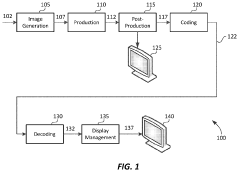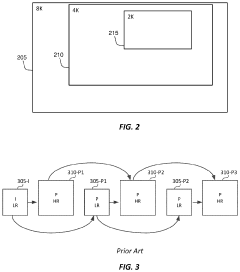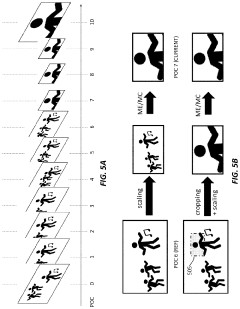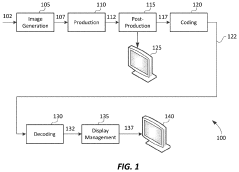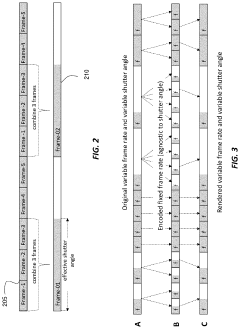Integration of Dolby Vision Features in Large-scale Live Events
JUL 30, 20258 MIN READ
Generate Your Research Report Instantly with AI Agent
Patsnap Eureka helps you evaluate technical feasibility & market potential.
Dolby Vision Evolution and Event Integration Goals
Dolby Vision has undergone significant evolution since its inception, transforming from a high dynamic range (HDR) technology primarily used in cinema and home entertainment to a versatile solution applicable to various content creation and display scenarios. The technology's journey began with its focus on enhancing the visual experience of pre-recorded content, offering superior contrast, brightness, and color accuracy compared to standard dynamic range (SDR) formats.
As the technology matured, Dolby Vision expanded its capabilities to support live broadcast applications, marking a crucial milestone in its evolution. This advancement opened up new possibilities for integrating Dolby Vision into large-scale live events, where real-time processing and transmission of HDR content became feasible. The evolution of Dolby Vision has been driven by continuous improvements in encoding efficiency, metadata management, and display technology compatibility.
The integration goals for Dolby Vision in large-scale live events are multifaceted and ambitious. Primarily, the aim is to deliver an unparalleled visual experience to audiences, both on-site and through broadcast mediums, by leveraging the full potential of HDR technology. This involves capturing, processing, and displaying content with enhanced dynamic range, wider color gamut, and improved color accuracy in real-time.
One key objective is to ensure seamless compatibility across various display technologies and viewing environments. This includes optimizing Dolby Vision content for LED screens in stadiums, broadcast monitors in production trucks, and consumer devices ranging from high-end televisions to mobile phones. The goal is to maintain consistent image quality and artistic intent across all viewing platforms.
Another critical integration goal is to streamline the production workflow for live events. This involves developing tools and processes that allow for efficient HDR grading, metadata management, and signal distribution without significantly increasing the complexity or cost of production. The aim is to make Dolby Vision integration as straightforward as possible for event organizers and broadcasters, enabling wider adoption across various types of live events.
Furthermore, the integration aims to enhance the storytelling capabilities of live event productions. By leveraging the expanded dynamic range and color palette offered by Dolby Vision, content creators can capture and convey the excitement, atmosphere, and nuances of live events more vividly and accurately. This goal extends to improving the visibility of details in both bright and dark areas of the image, crucial for events that may feature challenging lighting conditions or rapid transitions between different visual environments.
As the technology matured, Dolby Vision expanded its capabilities to support live broadcast applications, marking a crucial milestone in its evolution. This advancement opened up new possibilities for integrating Dolby Vision into large-scale live events, where real-time processing and transmission of HDR content became feasible. The evolution of Dolby Vision has been driven by continuous improvements in encoding efficiency, metadata management, and display technology compatibility.
The integration goals for Dolby Vision in large-scale live events are multifaceted and ambitious. Primarily, the aim is to deliver an unparalleled visual experience to audiences, both on-site and through broadcast mediums, by leveraging the full potential of HDR technology. This involves capturing, processing, and displaying content with enhanced dynamic range, wider color gamut, and improved color accuracy in real-time.
One key objective is to ensure seamless compatibility across various display technologies and viewing environments. This includes optimizing Dolby Vision content for LED screens in stadiums, broadcast monitors in production trucks, and consumer devices ranging from high-end televisions to mobile phones. The goal is to maintain consistent image quality and artistic intent across all viewing platforms.
Another critical integration goal is to streamline the production workflow for live events. This involves developing tools and processes that allow for efficient HDR grading, metadata management, and signal distribution without significantly increasing the complexity or cost of production. The aim is to make Dolby Vision integration as straightforward as possible for event organizers and broadcasters, enabling wider adoption across various types of live events.
Furthermore, the integration aims to enhance the storytelling capabilities of live event productions. By leveraging the expanded dynamic range and color palette offered by Dolby Vision, content creators can capture and convey the excitement, atmosphere, and nuances of live events more vividly and accurately. This goal extends to improving the visibility of details in both bright and dark areas of the image, crucial for events that may feature challenging lighting conditions or rapid transitions between different visual environments.
Market Demand for Enhanced Live Event Experiences
The integration of Dolby Vision features in large-scale live events has sparked significant market demand for enhanced live event experiences. As audiences increasingly seek immersive and high-quality entertainment, event organizers and broadcasters are under pressure to deliver cutting-edge visual experiences that captivate and engage viewers.
The live events industry, encompassing sports, concerts, festivals, and other spectacles, has witnessed a growing appetite for premium viewing options. This demand is driven by several factors, including the proliferation of high-resolution displays in homes and public venues, as well as the rising expectations of consumers accustomed to superior visual quality in other media formats.
Dolby Vision, with its advanced HDR (High Dynamic Range) technology, offers a compelling solution to meet these evolving market needs. The technology's ability to deliver a wider color gamut, higher contrast ratios, and enhanced brightness levels aligns perfectly with the desire for more lifelike and impactful live event presentations.
Sports broadcasting, in particular, has emerged as a key driver of demand for Dolby Vision integration. Major leagues and tournaments are exploring ways to differentiate their product and justify premium subscription fees, with enhanced visual experiences being a prime selling point. The technology's capacity to render vibrant colors and intricate details can significantly improve the viewing experience of fast-paced sports, making it easier for audiences to follow the action and appreciate the nuances of the game.
Music concerts and festivals represent another substantial market segment where Dolby Vision can make a significant impact. The technology's ability to capture and reproduce the vivid lighting and visual effects common in modern stage productions can create a more immersive experience for both in-person attendees and those watching live streams or broadcasts.
Corporate events and conferences are also showing increased interest in Dolby Vision technology. As these events increasingly adopt hybrid or fully virtual formats, the need for high-quality video transmission becomes paramount. Dolby Vision can enhance the visual appeal of presentations, product launches, and virtual exhibitions, helping to maintain audience engagement in remote settings.
The market demand extends beyond the events themselves to the ecosystem of content creation and distribution. Production companies, equipment manufacturers, and streaming platforms are all investing in Dolby Vision-compatible technologies to meet the growing expectations of event organizers and audiences alike.
As the technology becomes more widely adopted, there is a ripple effect on consumer electronics. The demand for Dolby Vision-capable displays and devices is increasing, creating a positive feedback loop that further drives the integration of this technology in live events.
The live events industry, encompassing sports, concerts, festivals, and other spectacles, has witnessed a growing appetite for premium viewing options. This demand is driven by several factors, including the proliferation of high-resolution displays in homes and public venues, as well as the rising expectations of consumers accustomed to superior visual quality in other media formats.
Dolby Vision, with its advanced HDR (High Dynamic Range) technology, offers a compelling solution to meet these evolving market needs. The technology's ability to deliver a wider color gamut, higher contrast ratios, and enhanced brightness levels aligns perfectly with the desire for more lifelike and impactful live event presentations.
Sports broadcasting, in particular, has emerged as a key driver of demand for Dolby Vision integration. Major leagues and tournaments are exploring ways to differentiate their product and justify premium subscription fees, with enhanced visual experiences being a prime selling point. The technology's capacity to render vibrant colors and intricate details can significantly improve the viewing experience of fast-paced sports, making it easier for audiences to follow the action and appreciate the nuances of the game.
Music concerts and festivals represent another substantial market segment where Dolby Vision can make a significant impact. The technology's ability to capture and reproduce the vivid lighting and visual effects common in modern stage productions can create a more immersive experience for both in-person attendees and those watching live streams or broadcasts.
Corporate events and conferences are also showing increased interest in Dolby Vision technology. As these events increasingly adopt hybrid or fully virtual formats, the need for high-quality video transmission becomes paramount. Dolby Vision can enhance the visual appeal of presentations, product launches, and virtual exhibitions, helping to maintain audience engagement in remote settings.
The market demand extends beyond the events themselves to the ecosystem of content creation and distribution. Production companies, equipment manufacturers, and streaming platforms are all investing in Dolby Vision-compatible technologies to meet the growing expectations of event organizers and audiences alike.
As the technology becomes more widely adopted, there is a ripple effect on consumer electronics. The demand for Dolby Vision-capable displays and devices is increasing, creating a positive feedback loop that further drives the integration of this technology in live events.
Current Challenges in Large-scale Live Event HDR Implementation
The implementation of High Dynamic Range (HDR) technology in large-scale live events presents several significant challenges. One of the primary obstacles is the complexity of managing and processing HDR content in real-time. Unlike pre-recorded content, live events require instantaneous processing and transmission of HDR signals, which demands substantial computational power and specialized equipment.
Another major challenge lies in the inconsistency of lighting conditions during live events. Outdoor venues, in particular, pose difficulties due to rapidly changing natural light. This variability can affect the HDR capture and display, potentially compromising the visual experience for viewers. Adapting to these dynamic conditions in real-time requires sophisticated algorithms and adaptive systems that can quickly adjust HDR parameters.
The bandwidth requirements for transmitting HDR content also present a significant hurdle. HDR signals contain more data than standard dynamic range (SDR) signals, necessitating higher bitrates for transmission. This increased data load can strain existing broadcast infrastructure, particularly in scenarios where multiple camera feeds need to be processed and transmitted simultaneously.
Interoperability between different HDR standards and display technologies is another critical challenge. With various HDR formats like Dolby Vision, HDR10, and HLG in use, ensuring compatibility across different capture, processing, and display equipment can be complex. This diversity in standards can lead to inconsistencies in how HDR content is rendered across different viewing platforms.
The cost factor associated with HDR implementation in live events cannot be overlooked. Upgrading to HDR-capable cameras, switchers, monitors, and transmission equipment represents a significant investment for broadcasters and event organizers. This financial barrier can slow down the widespread adoption of HDR technology in live event production.
Lastly, there's the challenge of maintaining consistent HDR quality throughout the production chain. From capture to transmission and final display, each step must preserve the HDR characteristics of the content. Any weak link in this chain can result in a degraded viewing experience, negating the benefits of HDR technology. Ensuring end-to-end HDR integrity requires meticulous calibration and monitoring at every stage of the production process.
Another major challenge lies in the inconsistency of lighting conditions during live events. Outdoor venues, in particular, pose difficulties due to rapidly changing natural light. This variability can affect the HDR capture and display, potentially compromising the visual experience for viewers. Adapting to these dynamic conditions in real-time requires sophisticated algorithms and adaptive systems that can quickly adjust HDR parameters.
The bandwidth requirements for transmitting HDR content also present a significant hurdle. HDR signals contain more data than standard dynamic range (SDR) signals, necessitating higher bitrates for transmission. This increased data load can strain existing broadcast infrastructure, particularly in scenarios where multiple camera feeds need to be processed and transmitted simultaneously.
Interoperability between different HDR standards and display technologies is another critical challenge. With various HDR formats like Dolby Vision, HDR10, and HLG in use, ensuring compatibility across different capture, processing, and display equipment can be complex. This diversity in standards can lead to inconsistencies in how HDR content is rendered across different viewing platforms.
The cost factor associated with HDR implementation in live events cannot be overlooked. Upgrading to HDR-capable cameras, switchers, monitors, and transmission equipment represents a significant investment for broadcasters and event organizers. This financial barrier can slow down the widespread adoption of HDR technology in live event production.
Lastly, there's the challenge of maintaining consistent HDR quality throughout the production chain. From capture to transmission and final display, each step must preserve the HDR characteristics of the content. Any weak link in this chain can result in a degraded viewing experience, negating the benefits of HDR technology. Ensuring end-to-end HDR integrity requires meticulous calibration and monitoring at every stage of the production process.
Existing Dolby Vision Integration Solutions for Live Events
01 High Dynamic Range (HDR) Technology
Dolby Vision utilizes HDR technology to enhance visual quality by expanding the range of both contrast and color. This results in brighter highlights, deeper blacks, and a wider color gamut, providing a more lifelike and immersive viewing experience.- High Dynamic Range (HDR) Technology: Dolby Vision utilizes HDR technology to enhance visual quality by expanding the range of both contrast and color. This results in brighter highlights, deeper blacks, and a wider color gamut, providing a more lifelike and immersive viewing experience.
- Dynamic Metadata Processing: Dolby Vision employs dynamic metadata processing to optimize the image on a scene-by-scene or even frame-by-frame basis. This allows for precise control over brightness, color, and contrast, ensuring that each scene is displayed at its best quality across different display devices.
- Display Calibration and Optimization: To maintain consistent visual quality across various displays, Dolby Vision incorporates advanced calibration and optimization techniques. These methods adjust the content to match the specific capabilities of each display, ensuring optimal performance regardless of the device's limitations.
- Color Management and Reproduction: Dolby Vision employs sophisticated color management systems to accurately reproduce a wide range of colors. This includes support for extended color gamuts and precise color grading, resulting in more vibrant and true-to-life images.
- Content Creation and Mastering Tools: To achieve superior visual quality, Dolby Vision provides content creators with advanced tools for mastering and grading. These tools enable precise control over the visual elements of the content, ensuring that the creator's intent is accurately preserved and displayed across different devices.
02 Dynamic Metadata Processing
Dolby Vision employs dynamic metadata processing to optimize the image on a scene-by-scene or frame-by-frame basis. This allows for precise control over brightness, contrast, and color, ensuring that each scene is displayed with optimal visual quality.Expand Specific Solutions03 Color Mapping and Gamut Expansion
The technology incorporates advanced color mapping and gamut expansion techniques to reproduce a wider range of colors more accurately. This results in more vibrant and true-to-life images, enhancing the overall visual quality of the content.Expand Specific Solutions04 Display Calibration and Optimization
Dolby Vision includes display calibration and optimization features that adapt the content to the specific capabilities of the display device. This ensures that the visual quality is maximized regardless of the display's limitations or characteristics.Expand Specific Solutions05 Content Creation and Mastering Tools
The technology provides content creators with specialized tools for mastering and grading content in Dolby Vision. These tools enable precise control over the visual elements, allowing creators to achieve their intended artistic vision and enhance the overall visual quality of the content.Expand Specific Solutions
Key Players in Live Event Technology and Dolby Vision
The integration of Dolby Vision features in large-scale live events represents an evolving market in the entertainment technology sector. This field is currently in a growth phase, with increasing demand for high-quality visual experiences at live events. The market size is expanding, driven by the entertainment industry's push for more immersive and technologically advanced productions. In terms of technological maturity, companies like Sony, Apple, and Sharp are leading the way with advanced display technologies and image processing capabilities. Smaller players such as SportsMEDIA Technology Corp. and Mixhalo are also contributing innovative solutions for live event enhancements. While the technology is advancing rapidly, there's still room for further development and integration across various event types and venues.
Sony Group Corp.
Technical Solution: Sony has developed advanced Dolby Vision integration solutions for large-scale live events, leveraging their expertise in professional broadcasting equipment. Their system utilizes high-dynamic-range (HDR) imaging technology to capture and process live content in real-time, ensuring optimal color grading and brightness levels for Dolby Vision-enabled displays. Sony's implementation includes specialized cameras, switchers, and monitors that support the Dolby Vision workflow, allowing for seamless integration into existing broadcast infrastructures[1]. The company has also introduced AI-driven algorithms to enhance the automation of HDR metadata generation, reducing the complexity of live Dolby Vision production[3].
Strengths: Extensive experience in professional broadcasting, comprehensive ecosystem of Dolby Vision-compatible products, and advanced AI-driven metadata generation. Weaknesses: Potentially higher implementation costs and complexity for smaller-scale events.
Apple, Inc.
Technical Solution: Apple has integrated Dolby Vision capabilities into its ecosystem, focusing on both content creation and consumption for large-scale live events. Their approach involves utilizing the powerful A-series chips in iPhones and iPads to capture, edit, and stream Dolby Vision content in real-time. Apple's ProRes RAW codec supports Dolby Vision, allowing for high-quality, low-latency transmission of live HDR content[2]. The company has also developed tools for content creators to easily apply Dolby Vision metadata to live streams, ensuring optimal viewing experiences across various Apple devices. Additionally, Apple has partnered with major sports leagues and event organizers to showcase Dolby Vision technology in live broadcasts, demonstrating its commitment to enhancing the visual quality of large-scale events[4].
Strengths: Seamless integration across Apple's ecosystem, powerful hardware capabilities, and partnerships with major event organizers. Weaknesses: Limited to Apple's ecosystem, potentially excluding non-Apple users from full Dolby Vision experiences.
Core Innovations in Large-scale HDR Live Broadcasting
Video coding using reference picture resampling supporting region of interest
PatentActiveUS20220286667A1
Innovation
- The implementation of reference picture resampling (RPR) with support for region of interest (ROI) in video coding, allowing for flexible scaling and decoding of specific regions within a video frame, enabling scalable distribution of HDR content compatible with various display resolutions and devices.
Frame-rate scalable video coding
PatentActiveUS20240251093A1
Innovation
- The development of a system that allows for frame-rate scalability in video coding, enabling processors to decode video frames at different frame rates and shutter angles by combining consecutive frames and using metadata to signal original frame rates and shutter angles, thereby supporting variable frame rates within a fixed frame rate container.
Infrastructure Requirements for Dolby Vision Live Events
The integration of Dolby Vision features in large-scale live events requires a robust and specialized infrastructure to ensure seamless delivery of high-quality, dynamic HDR content. At the core of this infrastructure is a high-bandwidth, low-latency network capable of transmitting the increased data volume associated with Dolby Vision content. This network must be designed to handle the real-time processing and distribution of HDR signals across multiple stages of the production and broadcast chain.
A critical component of the infrastructure is the implementation of Dolby Vision-compatible cameras and production switchers. These devices must be capable of capturing and processing the wide color gamut and high dynamic range inherent in Dolby Vision content. Additionally, the production environment needs to be equipped with HDR-capable monitors and reference displays to ensure accurate color grading and quality control throughout the live event.
The encoding and transmission infrastructure plays a pivotal role in maintaining the integrity of Dolby Vision content. This requires the deployment of advanced encoders that support Dolby Vision metadata and can efficiently compress the HDR signal without compromising quality. The transmission chain must also be equipped with compatible multiplexers and modulators to ensure the Dolby Vision signal is properly packaged and delivered to various distribution platforms.
On the playout side, the infrastructure must include Dolby Vision-enabled servers and playout systems capable of handling the dynamic metadata associated with the format. These systems need to be integrated with existing broadcast workflows, necessitating careful consideration of compatibility and potential upgrades to legacy equipment.
To ensure consistent quality across different viewing environments, the infrastructure should incorporate adaptive bit rate streaming technologies that can optimize the Dolby Vision content for various network conditions and device capabilities. This may involve implementing content delivery networks (CDNs) specifically optimized for HDR content distribution.
Lastly, the infrastructure must include robust monitoring and quality assurance systems capable of verifying the integrity of the Dolby Vision signal throughout the entire broadcast chain. This involves specialized test and measurement equipment designed to analyze HDR content and metadata, ensuring that the viewer experience meets the high standards set by Dolby Vision technology.
A critical component of the infrastructure is the implementation of Dolby Vision-compatible cameras and production switchers. These devices must be capable of capturing and processing the wide color gamut and high dynamic range inherent in Dolby Vision content. Additionally, the production environment needs to be equipped with HDR-capable monitors and reference displays to ensure accurate color grading and quality control throughout the live event.
The encoding and transmission infrastructure plays a pivotal role in maintaining the integrity of Dolby Vision content. This requires the deployment of advanced encoders that support Dolby Vision metadata and can efficiently compress the HDR signal without compromising quality. The transmission chain must also be equipped with compatible multiplexers and modulators to ensure the Dolby Vision signal is properly packaged and delivered to various distribution platforms.
On the playout side, the infrastructure must include Dolby Vision-enabled servers and playout systems capable of handling the dynamic metadata associated with the format. These systems need to be integrated with existing broadcast workflows, necessitating careful consideration of compatibility and potential upgrades to legacy equipment.
To ensure consistent quality across different viewing environments, the infrastructure should incorporate adaptive bit rate streaming technologies that can optimize the Dolby Vision content for various network conditions and device capabilities. This may involve implementing content delivery networks (CDNs) specifically optimized for HDR content distribution.
Lastly, the infrastructure must include robust monitoring and quality assurance systems capable of verifying the integrity of the Dolby Vision signal throughout the entire broadcast chain. This involves specialized test and measurement equipment designed to analyze HDR content and metadata, ensuring that the viewer experience meets the high standards set by Dolby Vision technology.
Content Creation Workflow for Dolby Vision Live Events
The content creation workflow for Dolby Vision live events involves a series of intricate steps designed to capture, process, and deliver high-quality HDR content in real-time. This process begins with the selection of appropriate camera equipment capable of capturing the wide dynamic range and color gamut required for Dolby Vision. Typically, high-end digital cinema cameras or broadcast cameras with HDR capabilities are employed to ensure the capture of the full range of highlights and shadows.
Once the footage is captured, it undergoes immediate color grading and tone mapping. This step is crucial in live events, as it requires real-time adjustments to maintain consistent image quality across various lighting conditions. Specialized hardware, such as Dolby Vision-enabled production switchers and monitors, are utilized to facilitate this process. These tools allow colorists to make swift adjustments to brightness, contrast, and color, ensuring that the HDR image is optimized for both SDR and HDR displays.
The next stage in the workflow involves metadata generation. Dolby Vision relies on dynamic metadata to instruct displays on how to render the content optimally. In a live event scenario, this metadata must be generated on-the-fly, requiring powerful processing units capable of analyzing the video signal in real-time and producing accurate metadata for each frame or scene.
Signal distribution is another critical component of the workflow. The Dolby Vision signal, along with its metadata, must be transmitted to various endpoints, including broadcast centers, streaming platforms, and on-site displays. This necessitates robust and high-bandwidth transmission infrastructure to handle the increased data load of HDR content without compromising quality or introducing latency.
Quality control is an ongoing process throughout the live event. Engineers must constantly monitor the output on both HDR and SDR displays to ensure that the content looks optimal across all viewing environments. This dual monitoring approach helps maintain consistency and prevents issues that may arise from the complexities of simultaneous HDR and SDR delivery.
Finally, the workflow must account for archiving and post-event distribution. The raw HDR footage, along with the generated metadata and any real-time adjustments made during the event, should be recorded and stored. This allows for potential remastering or repurposing of the content for future use, ensuring that the full quality of the Dolby Vision capture is preserved beyond the live broadcast.
Once the footage is captured, it undergoes immediate color grading and tone mapping. This step is crucial in live events, as it requires real-time adjustments to maintain consistent image quality across various lighting conditions. Specialized hardware, such as Dolby Vision-enabled production switchers and monitors, are utilized to facilitate this process. These tools allow colorists to make swift adjustments to brightness, contrast, and color, ensuring that the HDR image is optimized for both SDR and HDR displays.
The next stage in the workflow involves metadata generation. Dolby Vision relies on dynamic metadata to instruct displays on how to render the content optimally. In a live event scenario, this metadata must be generated on-the-fly, requiring powerful processing units capable of analyzing the video signal in real-time and producing accurate metadata for each frame or scene.
Signal distribution is another critical component of the workflow. The Dolby Vision signal, along with its metadata, must be transmitted to various endpoints, including broadcast centers, streaming platforms, and on-site displays. This necessitates robust and high-bandwidth transmission infrastructure to handle the increased data load of HDR content without compromising quality or introducing latency.
Quality control is an ongoing process throughout the live event. Engineers must constantly monitor the output on both HDR and SDR displays to ensure that the content looks optimal across all viewing environments. This dual monitoring approach helps maintain consistency and prevents issues that may arise from the complexities of simultaneous HDR and SDR delivery.
Finally, the workflow must account for archiving and post-event distribution. The raw HDR footage, along with the generated metadata and any real-time adjustments made during the event, should be recorded and stored. This allows for potential remastering or repurposing of the content for future use, ensuring that the full quality of the Dolby Vision capture is preserved beyond the live broadcast.
Unlock deeper insights with Patsnap Eureka Quick Research — get a full tech report to explore trends and direct your research. Try now!
Generate Your Research Report Instantly with AI Agent
Supercharge your innovation with Patsnap Eureka AI Agent Platform!
